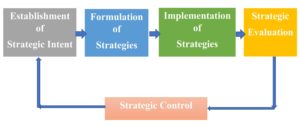Strategic Management Process
The strategic management process consists of different phases, which are sequential in nature. There are four essential phases of strategic management process. In different companies these phases may have different nomenclatures and the phases may have a different sequence, however the basic content remains same. The four phases can be listed as below:
- Establishing the hierarchy of strategic intent
- Formulation of strategies
- Implementation of strategies
- Performing strategic evaluation and control
- Establishing the hierarchy of strategic intent
The Strategic Planner has to define what is intended to be accomplished (not just desired). This will help in defining the objectives, strategies and policies. The hierarchy of strategic intent lays the foundation of the strategic management of any organization. In this hierarchy the vision, mission , business definition and objects are established. The strategic intent makes clear what an organization stands for. This phase consists of following steps:
a) Creating and communication a vision
b) Designing a mission statement
c) Defining the business
d) Setting objectives
i. Vision
States what an organization wishes to achieve in the long run
ii. Mission
It is the purpose for which organization is established.
iii. Business definition
It explains the businesses of an organization in terms of customer needs, customer groups and alternative technologies.
iv. Objectives
These are the ends which the organization seeks to achieve.
v. Goals
These are specific and time-based points of measurement.
vi. Policies
A policy is a definition of common purposes or organization components. The process of strategic management sometimes encompasses the formulation of important policies.
- Formulation of strategies
Environment and organizational appraisal help to find out the opportunities and threats operating in the environment and the strengths and weaknesses of an organization in order to create a match between them. In such a manner, opportunities could be availed of and the impact of threats neutralized in order to capitalize on the organizational strengths and minimize the weaknesses.
Strategies can be formulated after diagnosing the environment. Each strategy with suitable sub-strategies and alternative strategies should be available to top management. Thus, top management always mentors the administration with strategies which can be adapted from time to time. This phase consists of following steps:
a) Performing environmental appraisal
b) Doing organizational appraisal
c) Considering corporate level strategies
d) Considering business level strategies
e) Undertaking strategic analysis
f) Exercising strategic choice
g) Formulating strategies
h) Preparing a strategic plan
- Implementation of strategies
This is an important stage in strategic management process. Well designed strategies may fail in implementation. Hence, adaptability of strategies and implementation process should be clearly mentioned while formulating strategy. It is the strategist’s responsibility to take care of implementing strategies in accordance with the requirements of an organization. For the implementation of a strategy, the strategic plan is put into action through seven sub-processes:
a) Project Implementation
b) Procedural Implementation
c) Resource Allocation
d) Structural Implementation
e) Behavioural Implementation
f) Functional Implementation
g) Operational Implementation
a) Project Implementation
Deals with setting up the organization.
b) Procedural implementation
Deals with different aspects of the regulatory framework within which an organizations have to operate.
c) Resource Allocation
It relates to procurement and commitment of resources for implementation.
d) Structural Implementation
The structural aspects deals with the designing of appropriate organizational structures and systems, reorganising to match the structure to the needs of the strategy,
e) Behavioral Implementation
The behavioural aspects consider the leadership styles for implementing strategies and other issues like corporate culture, corporate politics and use of power, personal values and business ethics, and social responsibility.
f) Functional Implementation
The functional aspects relate to the policies to be formulated in different functional areas.
g) Operational Implantation
It deals with the productivity, processes, people and pace of implementing the strategies.
- Strategic Evaluation and Control
The strategist should evaluate each strategy after implementing them. The strategist should evaluate whether there is profit maximization or cost minimization or achievement of long run or short term goal whatever it may be. The feedback from strategic evaluation is meant to exercise strategic control over the strategic management process. Strategies may be reformulated, if necessary. Strategic evaluation and control thus consists of following steps:
a) Performing Strategic Evaluation
b) Exercising Strategic Control
c) Reformulating Strategies

